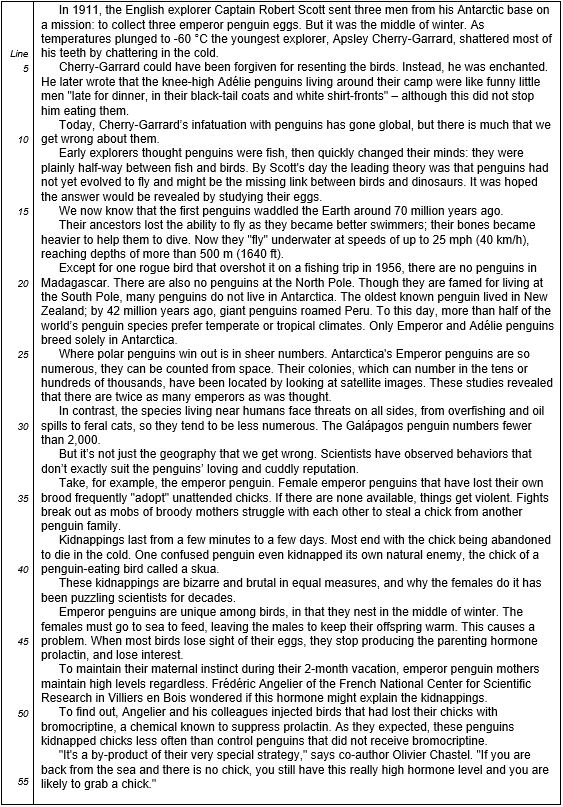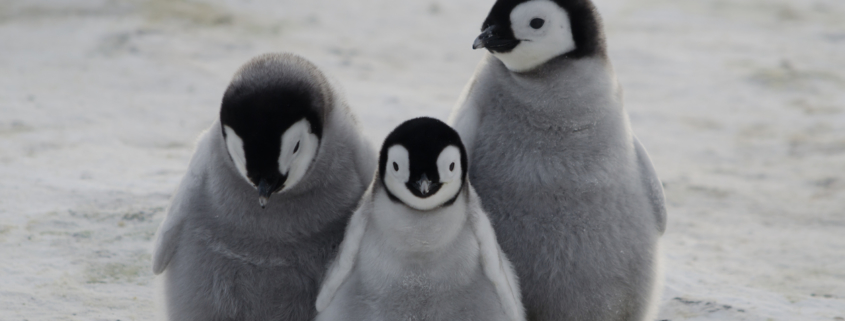January 20th is Penguin Awareness Day (not to be confused, we assume, with World Penguin Day, which is in April). The day is intended to remind us that many penguin species face threats from pollution and climate change—and to flood the Internet with cute penguin pictures. We’ve decided to celebrate Penguin Awareness Day in our own unique way: with some ACT reading practice!
As we’ve said before, practice is everything when it comes to ACT prep. ACT reading practice can be especially valuable: a big piece of success on the ACT reading section is speed, and the best way to boost reading speed is through plenty of practice.
How long is the ACT reading section?
The ACT reading test includes 4 passages and 40 questions—and you have just 35 minutes to finish it. That breaks down to just 52.5 seconds per question, and that doesn’t even include time to actually read the passages.
What are the passages like?
There are four passages in the ACT reading section: fiction narrative, social sciences, humanities, and natural sciences. Each passage is 500 to 750 words long (except for one paired set of passages, which total 500 to 750 words put together).
What are the questions like?
The ACT breaks its reading questions down into three big categories:
Key Ideas and Details
These questions make up more than half of the reading test. You’ll be asked to identify main ideas, summarize information or ideas, draw logical conclusions, and understand different relationships. These are What is the passage saying?
Craft and Structure
These questions make up a little over a fourth of the reading test. You’ll be asked about the meanings of different words of phrases, the author’s choice of words, the author’s purpose, points of view, and overall text structure. These are How is the passage saying it?
Integration of Knowledge and Ideas
These questions make up the remaining part of the reading test. You’ll be asked about claims and arguments, use of evidence, and connections between paired passages on related topics. These are How is the argument made?
Your ACT Reading Practice.
The passage below is a natural science passage about penguins—but since we wanted to make your ACT reading practice fun, this passage is a little more interesting than the somewhat dry science passages you typically find on the real ACT. To make this practice really count, time yourself. Try to get all 10 questions in less than 8 minutes.
Ready! Set! Go!

1. Which of the following best summarizes the author’s primary purpose in writing?
A) To relate the history of studies regarding penguins
B) To convince readers of the importance of protecting penguins
C) To suggest that penguins should not be a protected species
D) To argue that many beliefs about penguins are wrong
2. Based on information in the passage, we can infer that Scott sent men to gather emperor penguin eggs because:
E) He knew they would be worth a large sum of money upon his return to England.
F) He believed they would prove that penguins were closely related to fish.
G) He hoped they would show penguins to be the missing link between birds and dinosaurs.
H) He was collecting the eggs from all the species of Antarctica.
3. Which of the following describes the contrast between the prevailing beliefs regarding penguins in Scott’s time and in the modern age?
A) In Scott’s time, penguins were thought to be fish; today, we know they are birds.
B) In Scott’s time, penguins were thought to have not yet developed the ability to fly; today, we know that penguins lost the ability to fly.
C) In Scott’s time, penguins were thought to only live in Madagascar; today, we know they live only in Antarctica.
D) In Scott’s time, penguins were believed to fly; today, we know they only swim.
4. What was the outcome of the study conducted by Frédéric Angelier?
E) Angelier’s hypothesis was proven correct because the penguins administered bromocriptine stopped kidnapping chicks.
F) Angelier’s hypothesis was supported because suppressing prolactin reduced kidnapping incidents.
G) Angelier’s hypothesis was disproven because suppressing prolactin did not eliminate kidnapping altogether.
H) Angelier’s hypothesis was found to be irrelevant since an entirely different cause of the kidnapping behavior was discovered.
5. The passage indicates that polar penguins enjoy larger populations than other penguins primarily because:
A) They have evolved to withstand extreme temperatures.
B) They can swim faster than other penguins.
C) They engage in violent kidnapping behaviors.
D) They have been less impacted by human activity.
6. The author most likely included the sentences in lines 19 and 20 in order to:
E) Debunk common misconceptions about where penguins live.
F) Provide necessary detail to clarify the geographical areas where penguins can be found.
G) Establish his authority as an expert on penguin behavior.
H) Describe the history of penguin migration patterns.
7. As it is used in line 12, “plainly” most nearly means:
A) basically.
B) normally.
C) clearly.
D) barely.
8. Based on information in the passage, what would be the most likely outcome if penguins were to “stop producing the parenting hormone prolactin” when they lose sight of their eggs?
E) The female penguins would lose interest in their young when they travel to the sea to feed.
F) The male penguins would lose interest in their young when the females travel to the sea to feed.
G) Adult penguins would no longer be interested in producing young.
H) The female penguins would be unable to travel to the sea to feed.
9. Which of the following, if true, would best support the assertion that penguins engage in behaviors that are odds with their “loving and cuddly reputation”?
A) Many smaller penguin species mate for life.
B) Adélie penguins build their nests out of stones.
C) Male Adélie penguins have been observed killing penguin chicks.
D) Male emperor penguins guard their eggs while females go to the sea to feed.
10. The author’s tone can best be described as:
E) alarmed and pessimistic.
F) sincere and hopeful.
G) detached but persuasive.
H) light but informative.
Answers and Explanations
- D. Lines 9 and 10 introduce the author’s main purpose by stating that “there is much that we get wrong about [penguins].” The rest of the essay seeks to correct common misconceptions about the species.
- G. Lines 12 to 14 tell us that in Scott’s time, the prevailing theory was that penguins were the missing link between birds and dinosaurs and that the answer might be revealed by studying penguin eggs. This leads us to infer that Scott most likely wanted the eggs to study them for this purpose.
- B. Lines 12 and 13 tell us that in Scott’s time, it was believed that penguins had not yet learned to fly. Lines 16 and 17 tell us that today we know penguins lost the ability to fly.
- F. Choice D has no support in the passage. Choices A and C can be eliminated because the phrase “as they expected” in line 51 indicates that the scientists’ hypothesis was supported by the outcome—they did not expect suppressing prolactin to eliminate the kidnapping behavior altogether but rather to reduce it. This supports choice B.
- D. Lines 29 and 30 tell us that “species living near humans face threats on all sides…so they tend to be less numerous.” This supports choice D. Although some of the other statements might be true, the cause and effect relationship between those factors and the polar penguins’ larger numbers is not indicated in the passage. (For example, polar penguins engage in kidnapping, but this is not offered as a reason for their larger numbers.)
- E. The two sentences introduce the geography of penguin species by stating places where the penguins don’t live. If the author intended merely to clarify where penguins could be found, he would need to include an exhaustive list of everywhere penguins don’t live—not just two places. The context of passage leads us to conclude that these two particular places were included because these are places that people think penguins live.
- C. The context of the sentence suggests that the author is being somewhat sarcastic, using the word “plainly” to term something slightly ridiculous (at least from the modern perspective) as being obvious.
- E. Line 46 tells us that when birds stop producing the parenting hormone prolactin, they lose interest in their eggs/offspring. Penguins must maintain high levels of prolactin while away from their eggs in order to maintain the maternal instinct to care for their young upon their return.
- B. While choice B does not seem to reflect a “cuddly” reputation, it is not inherently at odds with it either. Choice C, on the other hand, is directly at odds with the term “loving and cuddly.”
- H. The author does not seem to express optimism or pessimism as he is not looking ahead to the future. Likewise, the author seems to be writing to inform rather than to persuade. The overall tone is lightened by several instances of humor (such as in the second paragraph with reference to Cherry-Garrard eating the penguins or in lines 19 and 20 with reference to the “rogue” penguin who overshot his mark).
Don’t forget






